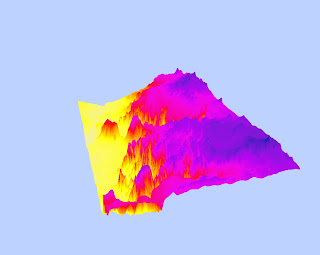Below are maps that I have created to trace the spread patterns across area and elevation. As you can see, the fire spread "up-hill," and into the higher elevation regions. If you scroll down, I will discuss the spread of each map.
 |
| Reference Map |
 |
| Fire Perimeter with Elevation |
 |
| Fire Stage 1: 5205 Acres |
 |
| Fire Stage 2: 13,891 Acres |
 |
| Fire Stage 3: 35,881 Acres |
 |
| Fire Stage 4: 115,575 Acres |
 |
| Fire Stage 5: 136,246 Acres |
According to my findings, locations uphill of a fire source are much more at risk than those that are downhill. Predictions about spread can also be made by studying the wind patterns. Subsequently, it would make sense to concentrate fire prevention resources near areas with other risk facts combined with a quick increase in slope. Structures and homes built in this area are at high risk.
Bibliography
"2009 California Wildfires." Wikipedia, the Free Encyclopedia. 1 Nov. 2010. Web. 23 Nov. 2010. <http://en.wikipedia.org/wiki/Station_Fire_(2009)#Los_Angeles_County>.
"All Station Fire Perimeters." Los Angeles County Enterprise GIS. Los Angeles County, 2 Sept. 2009. Web. 23 Nov. 2010. <http://gis.lacounty.gov/eGIS/?cat=11>.
"Digital Elevation Model." Seamless Data Warehouse. U.S. Geological Survey, 30 Sept. 2010. Web. 23 Nov. 2010. <http://seamless.usgs.gov/>.
"Facts About Fire." Ontario Ministry of Natural Resources. Ontario Ministry of Natural Resources, 5 June 2009. Web. 23 Nov. 2010. <http://www.mnr.gov.on.ca/en/Business/AFFM/2ColumnSubPage/STEL02_165825.html>.
"HowStuffWorks "Topography and Wildfires"" Howstuffworks "Science" Web. 23 Nov. 2010. <http://science.howstuffworks.com/nature/natural-disasters/wildfire3.htm>.











